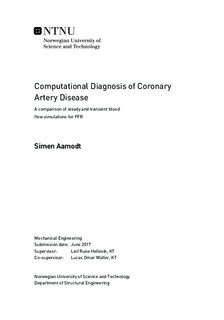Computational Diagnosis of Coronary Artery Disease - A comparison of steady and transient blood flow simulations for FFR
Master thesis
Permanent lenke
http://hdl.handle.net/11250/2454950Utgivelsesdato
2017Metadata
Vis full innførselSamlinger
Sammendrag
An emerging method for non-invasive diagnosis of coronary artery disease is the computational assessment of fractional flow reserve (FFR), a patient normalized physiological index quantifying arterial pressure drop. Computational FFR (FFRCT) is assessed through combining CT images with fluid dynamics simulations. To improve feasibility of such methods for clinical use, it is desirable to validate the assumption of quasi-steady behavior of coronary blood flows.
The present work was incorporated in the development of models and methods in NTNU's research project on FFRCT. Computational fluid dynamics (CFD) simulations were used in the validation of a coupled 3D-0D model for coronary circulation. The model was further used in patient-specific simulations tailored to the data from 8 patients recruited at St. Olavs Hospital, Trondheim. Steady and transient blood flow simulations were compared to evaluate the implications of neglecting pulsatility in the calculation of FFRCT.
The results demonstrate that assuming steady flow conditions introduce negligible errors compared with other model errors and the variations in repeated invasive FFR procedures. The FFRCT results obtained with the present methodology and models are promising, yet with occasionally severe errors in per-patient comparison with invasive FFR. Further development of models and methods is required for adequacy in diagnostic applications.
